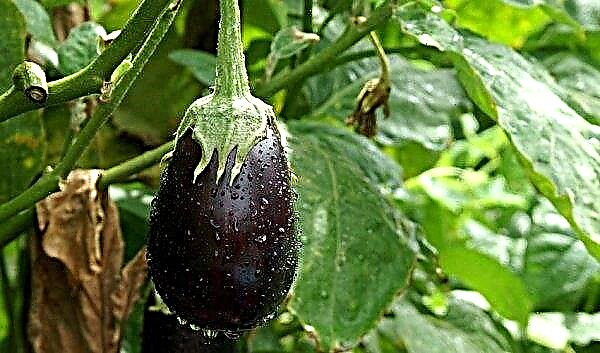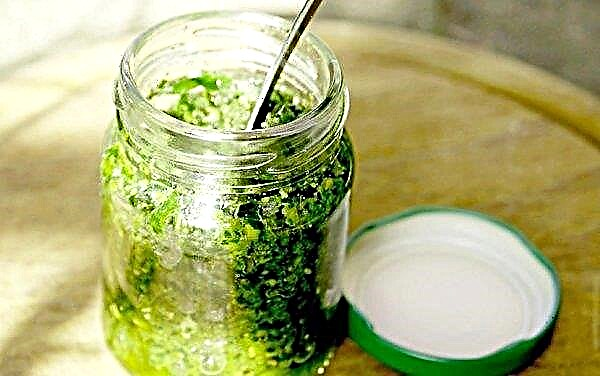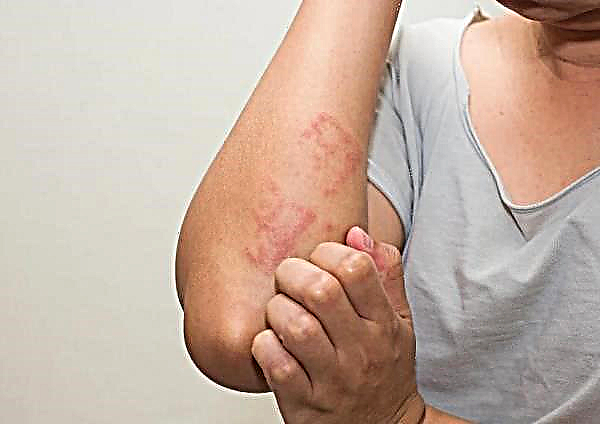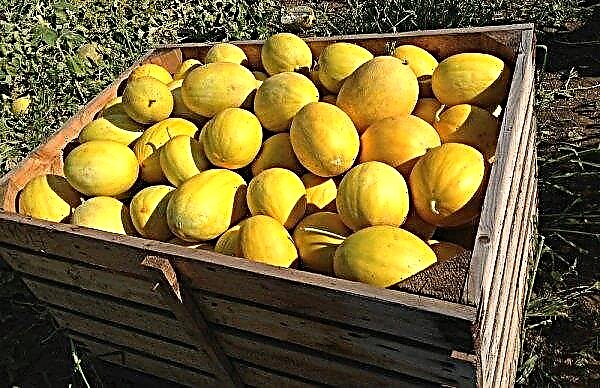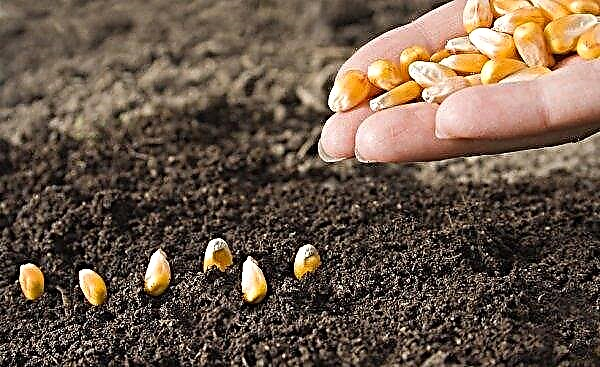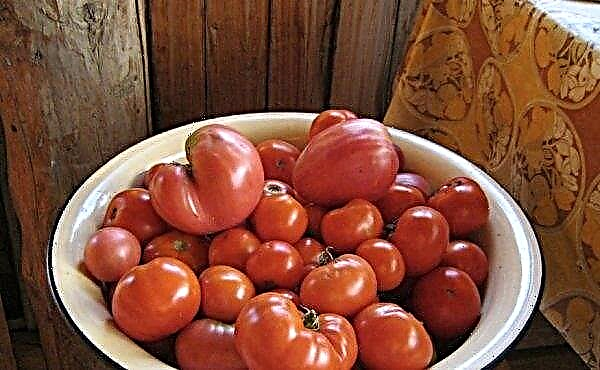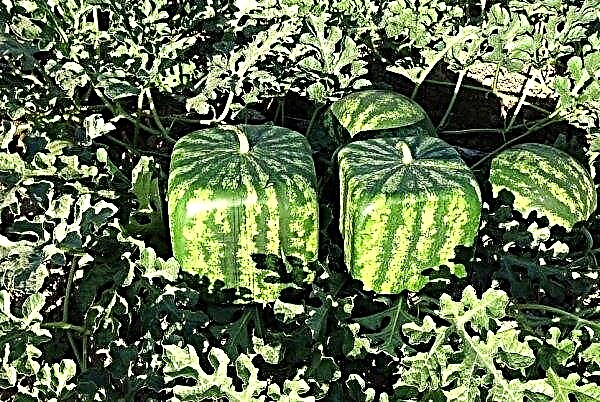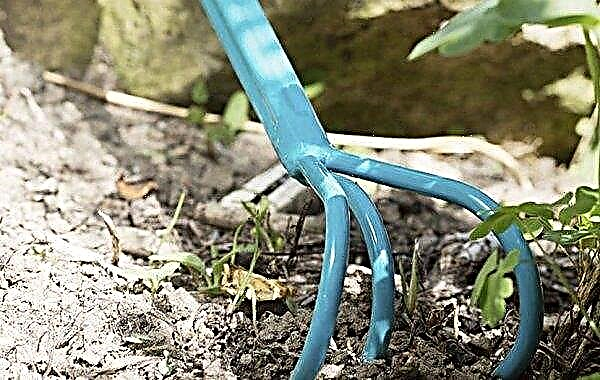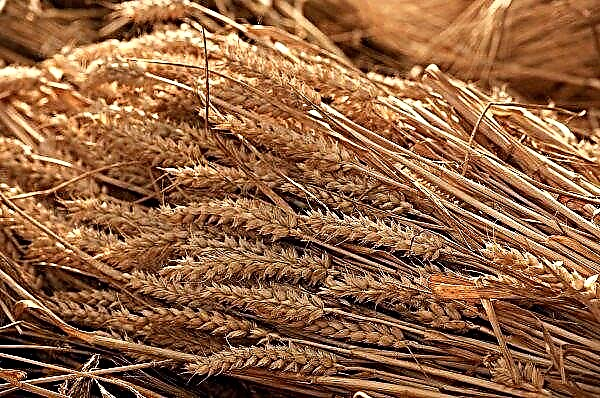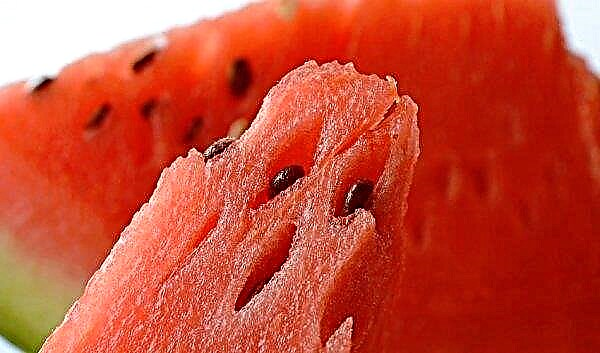The juicy and thawing fruits of the Lada pear variety are a wonderful treat. With its universal purpose (to use it both fresh and for processing), this variety takes pride of place among the most common and recommended for cultivation. This article discusses the description of the Lada pear tree, as well as the rules and recommendations for caring for it in order to obtain the most rich and high-quality crop.
Breeding History and Variety Breeding Region
The Lada selection chronicle reports that the variety was bred at the Moscow Agricultural Academy (now the Russian State Agrarian University - Moscow Agricultural Academy named after K.A. Timiryazev) by specialists Potapov and Chizhov. In order to develop a new species, such varieties as Olga and Forest Beauty were used. In the state register, the variety found its place in 1993.
 In the first year of fruiting, extra young ovaries must be thinned out to form the correct crown of the tree
In the first year of fruiting, extra young ovaries must be thinned out to form the correct crown of the tree
The regions of the greatest distribution of Lada are Bryansk, Volgograd, Vladimir, Kaluga, Ivanovo, Tula, Ryazan, Smolensk and Moscow regions of the Russian Federation, Krasnoyarsk Territory, as well as Chernozemye.
Description and characteristic
Below are the main parameters that externally describe the representatives of the Lada pear variety.
Did you know? According to historical data, the homeland of the pear is South Asia. It was from there that she came to Europe a few millennia BC, but these plants were brought to America only four centuries ago.
Tree description
An adult tree is characterized by average height (up to 2.5 m), insignificant crown density and density of foliage. In young seedlings (up to 3 years), the crown is funnel-shaped, in contrast to the pyramidal in adults (4 years or more). The main part of the trunk is characterized by a soft gray color. The processes of considerable length are characterized by a pronounced brown color, a slight curvature with an oval-shaped cross section. Short stems in the region of internodes have a relatively small shoot thickness, as well as a low number and weak severity of lentil tubercles. Fruit-bearing pear tree Lada
Fruit-bearing pear tree Lada
The shape of the saturated green leaves is ovate-pointed, the outer surface is preferably shiny, in contrast to the back (matte and having a slight roughness, as well as small teeth on the edges). The sheet plate has an average thickness and a good level of elasticity.
The rudiments of plant shoots differ in a conical shape with a slight elongation and pointedness. Those buds, which become more oval as they mature, begin to produce racemose inflorescences of 5–7 buds with large white flowers and indivisible petals.
Important! In the first year of the fruiting process of a young tree, it is imperative to remove the extra, only tied fruits, in order to form a regular and beautiful crown of the pear.
Fruit Description
The fruits are small (their mass does not exceed 120 g), the shape is standard. Smooth and thin, shiny peel of the fruit is distinguished by a light straw color with a delicate scarlet rosy barrel. Subcutaneous points characteristic of this type of fruit are virtually invisible. The “rusted” net on the fruit is weakly expressed, it is seen only at the base of the peduncle. The tail of the fetus is short in length, medium in thickness, and there is no funnel. In the middle of each fruit, you can count from 5 to 7 grains of brown color and medium size. The excellent taste of the fruits of the pear Lada is combined with their beautiful color during full maturity
The excellent taste of the fruits of the pear Lada is combined with their beautiful color during full maturity
The pulp of fruits of a light lemon shade is characterized by a loose structure, medium juiciness. The taste of fruits is sweet with a slight acidity, there is no pronounced aroma. Taste properties of fruits are at a high level, on a 5-point scale, reaching 4.4.
The timing of flowering and fruiting
Lada belongs to the early summer varieties: the tree begins to bloom in late April, and bears fruit already in August. Pears hold on to the stalks and do not crumble for a long time after ripening. As the pears reach a golden color with an amber hue, as well as the appearance of a light side blush, you can begin to harvest.
Find out about other summer pear varieties:
The variety is a self-made species, but for pollination and further fruiting, plants need other flowering pollinators - for example, pears Otradnenskaya, Chizhovskaya, Rogneda, Cosmic and Severyanka.
After the first planting of a sapling, from 2 to 4 years is enough for the first fruits to start on the tree, which indicates the early maturity of the variety.
Grade stability
The resistance of this variety of pears to frost is impressive: in the cold season and during frosts (in the mid-climate climate), trees can not even be covered. Considering the thermophilic nature of this culture in general, a similar level of low sensitivity to subzero temperatures is rare. With regard to regions with colder climatic conditions, it is recommended to protect the near-trunk region of the soil in which the pear is grown by mulching with a layer of peat of an average thickness of 30 cm.
Also This variety is very resistant to diseases common in pears, such as scab, rust, fruit rot, bacterial burns and powdery mildew, as well as pests such as hawthorn, tinnitus, moth. With improper care, however, the level of resistance of the variety to ailments and parasite damage may decrease.
Video: Lada Pear
Advantages and disadvantages of the variety
- The obvious advantages of the variety include:
- high frost resistance;
- unpretentiousness in leaving;
- early maturity and variety;
- duration of preservation on branches, insolubility;
- the abundance of the crop;
- universal use of fruits;
- resistance to certain types of diseases.
- There are practically no significant minuses in the Lada variety, except:
- low ability to transportability;
- short fruit preservation after harvesting from trees;
- low drought tolerance.
Landing Features
It is important to know the basic nuances regarding the proper selection of a seedling for planting, as well as rooting a tree for subsequent successful development.
Did you know? The Chinese people consider the pear a symbol of immortality because of the very high strength of this tree. It is considered a bad sign in the country to see a broken pear, and cutting a tree is strictly prohibited.
How to choose seedlings for planting
When you buy pear seedlings of any kind, especially Lada, you need to make sure that their age does not exceed two years, because otherwise their root system simply will not take root. The parameters of the height and thickness of the trunk of a one-year-old seedling are 1 m and 1 cm, respectively. A tree 2 years old does not exceed a height of 1.5 m, and the thickness of its stem is about 1.5 cm.
Carefully inspect the roots of the seedling: three (usually) main thick roots 20-30 cm long (for one and two year old, respectively) should not be overdried and peel off (if such a sign is available, then the tree is frozen). Kidney development and lack of leaflets are another characteristic of healthy young plants.
When to plant
When planting seedlings of any pear, it is necessary to take into account the time of year. It is optimal to do this in the spring (on April 20-30). Due to the potentially weak rooting, it is not recommended to plant sprouts in the autumn, however, the Lada pear variety, as practice shows, due to its resistance to frost, also survives well when planted in the fall (no later than October 15).
Video: Pear Planting Instructions
How to choose and prepare a place for landing
The variety is not very whimsical to the choice of soil, so it is grown almost everywhere, however for better yields, you should choose loamy or forest earth mixtures, as well as chernozem, and dig the soil first.
As a place for future planting of seedlings, it is necessary to prepare a well-lit, but with a limited supply of drafts and direct sunlight, area (to avoid weathering and drying out of the leaves of the plant). It is also worth making sure that the groundwater level is no closer than at least 3 meters from the ground.
Important! Preliminary preparation of the pit for planting a seedling is carried out with the aim of shrinkage of the soil due to its drying. If this process is not carried out, then in the first 4 weeks the plant literally will pull deep and the root neck will be below ground level, which will entail rotting of the root system and the death of the seedling.
Landing technology
The algorithm for planting a seedling of a pear of Lada variety is as follows:
- Preparing the acquired seedling for planting: cutting the most powerful roots by about 10–12 cm, removing the top so that the result is a straight stick without branches 70–80 cm long; placing the seedling in a bucket of water for 60 minutes, after which - immersing the root system of the plant for several minutes in a mash of ash, water and earthy soil extracted from the pit.
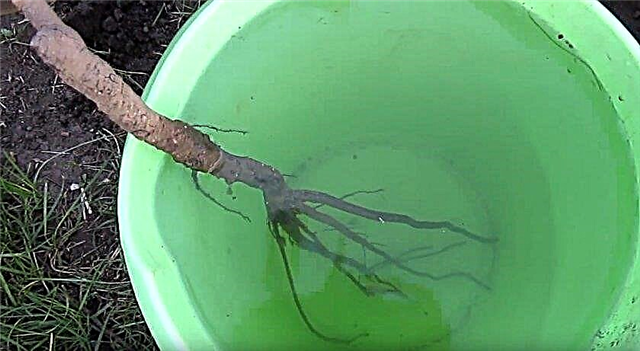
- The formation of a hole with an average depth of not more than 70 cm and a diameter of about 100 cm, taking into account the large-scale size of the root system (for the free placement of the plant and to avoid bending of the roots). If a plant is planted in autumn, then it must be done in 14–21 days, and if in spring, then from autumn.
- Careful loosening of the bottom of the pit, the formation of notches on the walls of the hole in order to improve air exchange and stimulate the growth of the root system.
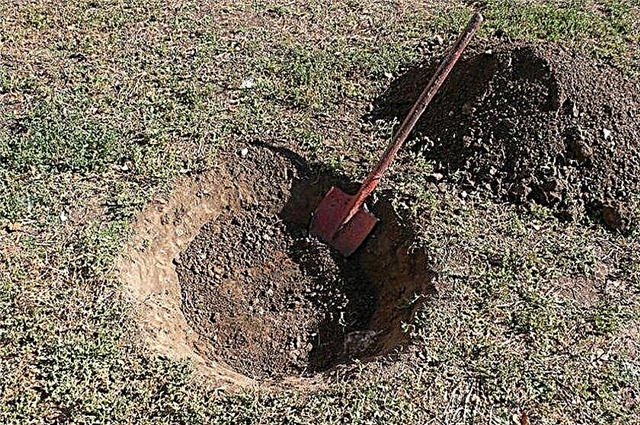
- The introduction of basic organic fertilizers (potassium salt, superphosphate and compost, or coarse river sand) into the formed hole, loosening the soil.
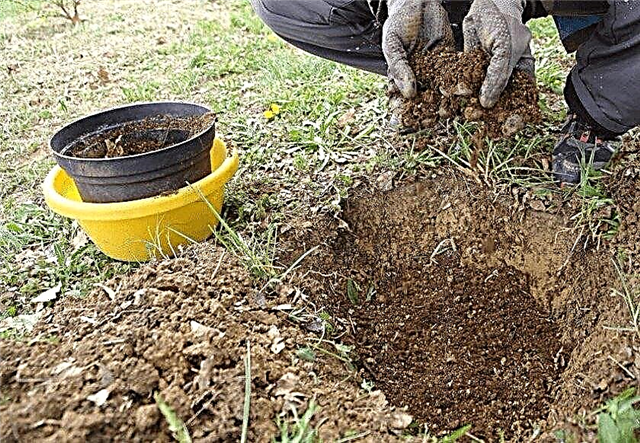
- Placing the peg in the pit so that it protrudes 60 cm above the ground, and is preferably located on the south side of the potential placement of the sprout (this will avoid deformation of the crown of the plant).
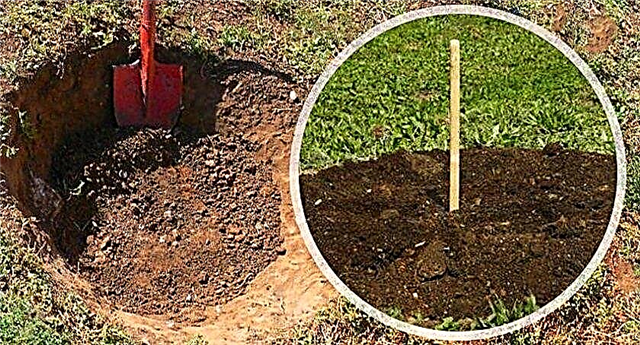
- Adding to the hole (in addition to the above fertilizers) turf, horseback ground and talkers into which the seedling was immersed.
- The formation of a small knoll at the bottom of the fossa, the location of the root system of a seedling in the form of a fan, the plant falling asleep with the ground in which it was grown before purchase.
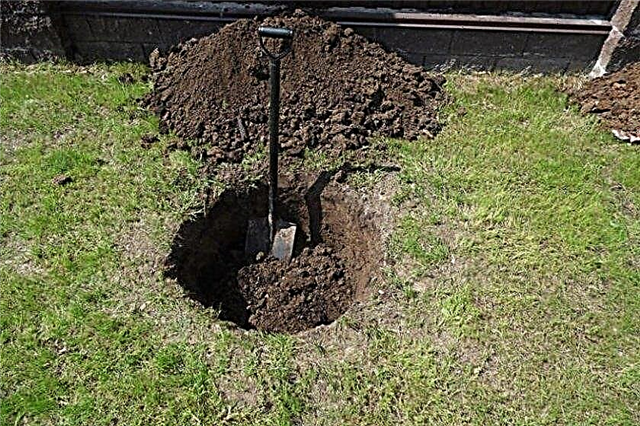
- Compliance with the correct placement of the root neck above the ground: approximately 5-7 cm; when filling the hole with soil - periodically shaking the seedling to avoid the formation of voids in the middle of the hole.
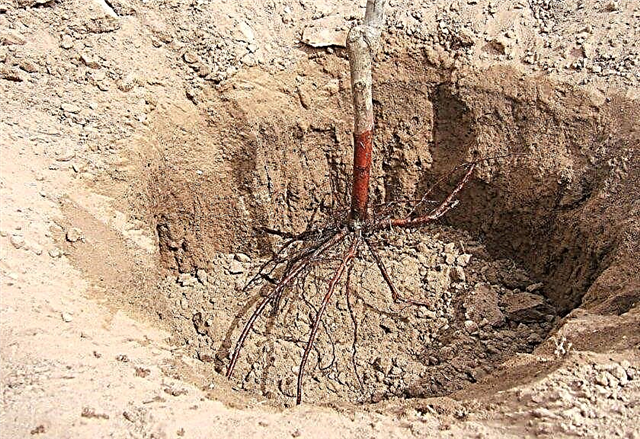 When planting a pear, make sure that the root neck is 5-6 centimeters above the ground
When planting a pear, make sure that the root neck is 5-6 centimeters above the ground - Gently tamping the soil around the plant, abundant watering, sprinkling with humus or peat on top to maintain soil moisture.
- Carefully tying a seedling to a pre-dug peg.

Care Features
The main points in caring for a variety of pear Lada is the timely implementation of the following actions:
- preventive spraying of a tree with special means in order to protect it from diseases and pests;
- cleaning and processing of fallen leaves;
- elimination of weeds in the soil in which the tree is grown;
- adequate watering (prevention of both aridity and excessive soil moisture);
- regular careful inspection of the trunk, branches and hardwood for signs of irregularities in the development process.
Did you know? If the pulp of the pear has a brown tint in the section, this indicates a high iron content.
How to water
The Lada pear tree itself does not need frequent watering, except during periods of prolonged drought. If you water it often and not on demand (if there is sufficient natural rainfall), you can harm the root system and thus cause unwanted lesions that can fatally injure the tree.
Basically, watering is carried out in the summer from the beginning of June, especially in the dry periods, once every week according to the scheme: 2-3 buckets of water under one young, and 4-5 - under one adult treeand then experts recommend loosening the soil around the trunk to avoid the formation of an airtight crust.
How often is it necessary to feed
The stem element of the trunk before wintering is subjected to treatment mainly with iron minium or calcareous mixture - to protect the plant from attack and damage by rodents, as well as from burns in early spring.
At the end of wintering, in spring (after snow melt and stable dry weather is established) the plant needs to be fertilized with nitrogen fertilizers - fresh organic matter in the form of manure or compost mixed with water in a proportion of 500 g per 10 liters.
As for the autumn support (in October), in this case fertilizers of mineral origin are best suited: granular superphosphate (30 g), potassium chloride (15 g), wood ash (150 ml), which are introduced into the dug up soil. The mass of the elements is calculated per 1 m².Important! At the end of the winter period, it should be ensured that during the thaw, wet snow does not adhere to the branches of the pear. The mass of frozen snow cover can easily break thin branches.

When and how to trim
Pear should be pruned 2 times a year: in spring and autumn. This procedure is carried out to increase the level of tree productivity due to thinning of the crown, and to normalize the uniform illumination of all healthy branches. Dry and damaged, as well as interwoven and growing inside a deciduous crown tree branches are subject to complete removal using a sharp secateurs; partial shortening - too long.
Cut-off zones must be treated with special garden grease - var, or traditional clay mash. The composition of the garden varieties includes: beekeeping products, natural fats used in food, resin or rosin, solid oil or antifreeze, as well as a special drug used in the agricultural sector - “Heteroauxin”.
Diseases and pests, methods of control and prevention
Like any problem, an attack of a disease or parasite on a pear is easier to prevent than to deal with its consequences later, since the level of resistance of a variety to certain irritants can be significantly affected by conditions independent of proper planting and tree care.
| Disease / pest, signs of damage | Prevention methods, elimination actions |
Moniliosis (fruit rot):
| Preventive measures: regular and timely cleaning of the territory from fallen leaves and affected fruits. Methods of struggle:
|
Powdery Mildew:
| Preventive measures:
Methods of struggle:
|
Rust: the appearance on the outer sides of the leaves of bright orange spots. | Preventive measures:
Methods of struggle:
|
Pear copperwood:
| Preventive measures:
Methods of struggle:
|
Hawthorn: twisting damaged leaves into a tube, which subsequently serve as a winter lodging for the caterpillars. | Preventive measures:
Methods of struggle:
|
Winter moth:
| Preventive measures:
Methods of struggle:
|
Harvesting and storage
To the final stage of agriculture - harvesting pear crops - you can start after the fruits turn out to be preferably yellow in the area of the cuttings. As a rule, this happens at the beginning of August, but since the fruits of this variety hold very well on the stalks and do not crumble, the harvesting period can be delayed even until mid-September (which, however, may partly affect the taste of the fruit). It is best to harvest the entire crop at once, or in several stages, but without long breaks.
Since the fruits of this variety are poorly preserved, it is not recommended to keep them unused for a long time even in the refrigerator or cellar. For a month after collection, they can be consumed fresh, covered with compote, jam or baked. But still, if you did not manage to process the entire volume of the crop, it is allowed to place the fruits in plastic containers or wooden boxes, separating the tiers with thin paper or straw. The obvious disadvantage of the variety is the very low transportability during transportation and the impossibility of long storage
The obvious disadvantage of the variety is the very low transportability during transportation and the impossibility of long storage
So, Lada is considered one of the most popular early varieties of pear, as evidenced by its wide distribution. He pleases with his unpretentiousness in leaving, and subject to all his rules gives a tasty and rich harvest.
Network user reviews
ADVANTAGES: It does not get sick at all, there are no worms at all, there are no aphids and other infections on the leaves and trunk.
DISADVANTAGES: If it can be called a minus: fruiting is too high, which breaks the branches. Fruits do not last more than 2-3 weeks. So sweet that wasps and bees come in.
Hello! My husband once took a garden plot in the village and decided to set up a garden. The question arose about quality plants, where the pear must have entered. Turned to the local private nursery "Crane". The selection criterion was as follows: the pear variety had to be specially bred for the Urals. After all, the temperature in winter reaches -40 and even -50, strong winds, sudden changes in temperature. When handling, they drew attention to the Lada variety: the fruits are large, delicate, very juicy, practically not grainy, do not blacken inside, do not bind in the mouth, are unpretentious. I bought a three-year-old seedling in the spring of May 2003. He took root well and wintered. The next year, the tree gave 3-4 pears. It grows very fast. The pear crown for the season increases by 25-30 cm. Now, in total, she is 15 years old. Every year the crop is more and more. A lean year was only once, when during flowering there was a severe frost of about -7-8 degrees, then it did not bear fruit. This year, more than 25 buckets of pears came out. We did not have time to process it)) There are so many fruits that the branches break under the load of fruits and from the wind We are not even happy that it bears fruit so much. Weight 200-250 grams. Suitable for any kind of canning: compotes, preserves, juices, marmalades and marshmallows. Fruits of this variety have never been found on sale.






 When planting a pear, make sure that the root neck is 5-6 centimeters above the ground
When planting a pear, make sure that the root neck is 5-6 centimeters above the ground